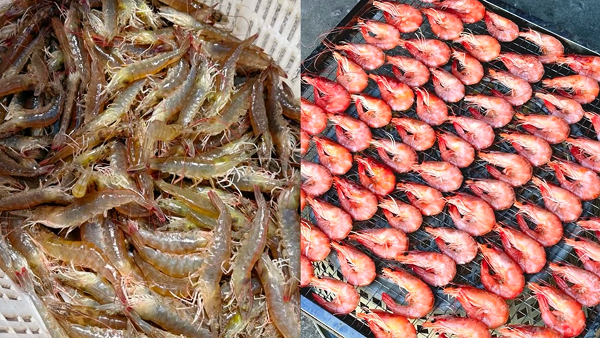Tianjin isn’t just a port city—it’s one of Northern China’s true food heavens.
Locals like to say: “Eat fish and shrimp, and make Tianjin your home” (吃鱼吃虾,天津为家).

Here, land meets sea, and rivers meet people. Tianjin cuisine (津菜) reflects this harmony—combining freshwater seafood, hearty northern flavors, and humble snacks that have fed emperors, dockworkers, and storytellers for centuries.
If you’re looking for things to do in Tianjin, start with the food—it’s the easiest way to feel the city’s humor, warmth, and rhythm.
1. The “Four Winter Treasures” of Tianjin (冬令四珍)
When winter arrives and the Hai River glistens under frost, Tianjin’s kitchens celebrate the season with the legendary “Four Winter Treasures”—Iron Sparrow (铁雀), Silverfish (银鱼), Yellow Chives (韭黄), and Purple Crab (紫蟹).

These ingredients define Tianjin food at its most elegant—earthy yet refined, humble yet poetic.
Iron Sparrow (铁雀)
Once a delicacy of the old city, these small birds were deep-fried to crisp perfection, then tossed with scallions and sweet bean paste. The dish symbolized warmth and energy in harsh northern winters. It’s no longer served today (for conservation reasons), but its legend lives on in Tianjin’s culinary lore.
Silverfish (银鱼)
Tianjin’s silverfish come from the Sancha Estuary (三岔河口), where five rivers meet the sea. These tiny, transparent fish are tender, sweet, and quick to cook—often stir-fried with egg or steamed for their natural umami.
In winter, fishermen call them “the pearl of the Hai River.”
Purple Crab (紫蟹)
Found in the Beitang region, these crabs turn deep violet after the first frost. Their meat is firm yet juicy, and their roe—bright orange—is prized for its creamy texture.
Locals believe the flavor of Beitang’s purple crab is “as rich as the winter sea, and as fleeting as it.”
Yellow Chives (韭黄)
A creation of human craftsmanship, Yellow Chives are grown in covered greenhouses during the Qing Dynasty to block sunlight, producing tender, golden shoots with a subtle fragrance.
Signature Dish: Silverfish & Purple Crab Hotpot (银鱼紫蟹火锅)
This beloved winter hotpot blends river and sea. Fresh silverfish and purple crab simmer with pickled cabbage and ginger in a creamy, aromatic broth. The result is rich, fresh, and deeply comforting—true Tianjin cuisine in a bowl.
2. The “Three Culinary Legends of Tianjin” (津门三绝)
Every food lover must try the Three Culinary Legends of Tianjin—famous across China and beyond:
1. Goubuli Baozi (狗不理包子)

Tianjin’s most iconic dish. These plump steamed buns are filled with juicy pork or beef and sealed with intricate folds. The name means “The Dog Ignores You”—a reference to a vendor so focused on perfecting his baozi that he ignored customers.
👉 Tip: Try them fresh from Goubuli’s century-old shop near Tianjin Railway Station.
2. Ear-Hole Fried Cake (耳朵眼炸糕)

Named after the tiny “Ear-Hole” alley where they originated, these glutinous rice cakes filled with red bean paste are fried to golden crispness. Sweet, chewy, and perfectly nostalgic.
3. Shibajie Mahua (十八街麻花)

Crispy twisted dough sticks coated with sesame or honey. Locals snack on them with tea or gift them to friends. Visit the original shop on Shibajie Street—a true Tianjin food pilgrimage.
3. Rice, Banquets, and Family Feasts
Xiaozhan Rice (小站稻)
Grown in the fertile wetlands south of the city, Xiaozhan Rice once supplied the imperial court. Fragrant, glossy, and slightly sticky, it remains one of Tianjin’s most famous foods.

The “Eight Big Bowls” (八大碗)
A northern-style banquet tradition, Tianjin’s version has multiple tiers:
- Rough Eight (粗八大碗): everyday favorites like stir-fried shrimp and braised meatballs.
- Fine Eight (细八大碗): refined dishes such as chicken in clear soup and sea cucumber balls.
- High Eight (高八大碗): luxury versions featuring shark fin, bird’s nest, and abalone.

The “Four Great Braises” (四大扒)
Complementing the banquet are the famous “Four Braised Dishes”—slow-cooked in soy and sugar until tender and glossy. Variations include braised whole chicken, duck, pork knuckle, fish, gluten, and sea cucumber.
Every dish emphasizes balance, symmetry, and harmony—hallmarks of Tianjin cuisine.

4. The Signature Dishes of Tianjin Cuisine (津菜)
Tianjin’s local cuisine—known as Jincai (津菜)—is one of China’s most distinctive regional culinary schools. It blends the rich, bold flavors of the north with the freshness of the sea, echoing the city’s identity as both a port and a river town.
Here are some of the city’s most representative dishes:
- Abalone Shrimp (鲍鱼虾) – A symbol of celebration and prosperity, this dish brings together the ocean’s two treasures—abalone and shrimp. The shrimp are lightly stir-fried to preserve their sweetness, while the abalone is braised in oyster sauce until tender and glossy.
- Zeng Beng Carp (罾蹦鲤鱼) – Perhaps the most famous of all Tianjin classics, this dish literally means “the carp that leaps into the net.” Traditionally, a live yellow carp is caught fresh from the river, cleaned, and instantly deep-fried—so that it seems to “jump” into the pan, sizzling with vitality. The fish is then glazed in a sweet-and-sour sauce made from vinegar, sugar, and rice wine, giving it a crisp skin and tender flesh.
- Shrimp Roe Braised Cabbage (虾脑扒白菜) – The cabbage is simmered slowly in a stock flavored with shrimp heads and roe, giving it a golden-orange hue and a deep umami flavor. This method—called pa (扒), or “braising in sauce”—is a signature of Tianjin cuisine.
- Braised Vegetarian Delight (扒全素) – an elegant temple-style dish showing Tianjin’s Buddhist roots. Showcase of the pa technique, this “complete vegetarian braise” brings together mushrooms, tofu, gluten, bamboo shoots, and seasonal greens, slow-cooked in soy-based sauce until every ingredient absorbs the same savory depth.

Bridge Spot to Traveler: Where to Taste the Real Tianjin
Forget fancy restaurants. The best Tianjin food experiences happen where the locals eat:
Breakfast: Savory jianbing (煎饼) with soy milk from a street cart steaming in the winter air.
Lunch: A bubbling pot of silverfish and crab stew by the Sancha Estuary.
Tea Time: Crunchy mahua with jasmine tea on Ancient Culture Street.
Dinner: “Eight Big Bowls” shared with laughter in an old courtyard home.
Here, meals aren’t just eaten—they’re stories told, jokes shared, and memories made.
Supper Social with Bridge with Locals
Guidebooks can list restaurants, but locals bring the table to life.
With Bridge with Locals, you can:
- Join a Tianjin family for a home-cooked Eight Big Bowls dinner.
- Visit Yangliuqing and learn how mahua is hand-twisted.
- Sit in an old teahouse with a friend who explains why Tianjin jokes always start with food.
Because in Tianjin, food isn’t just eaten—it’s shared, remembered, and enjoyed.
So come hungry, come curious—
and let Tianjin feed you with its stories.








Leave a comment
This site is protected by hCaptcha and the hCaptcha Privacy Policy and Terms of Service apply.